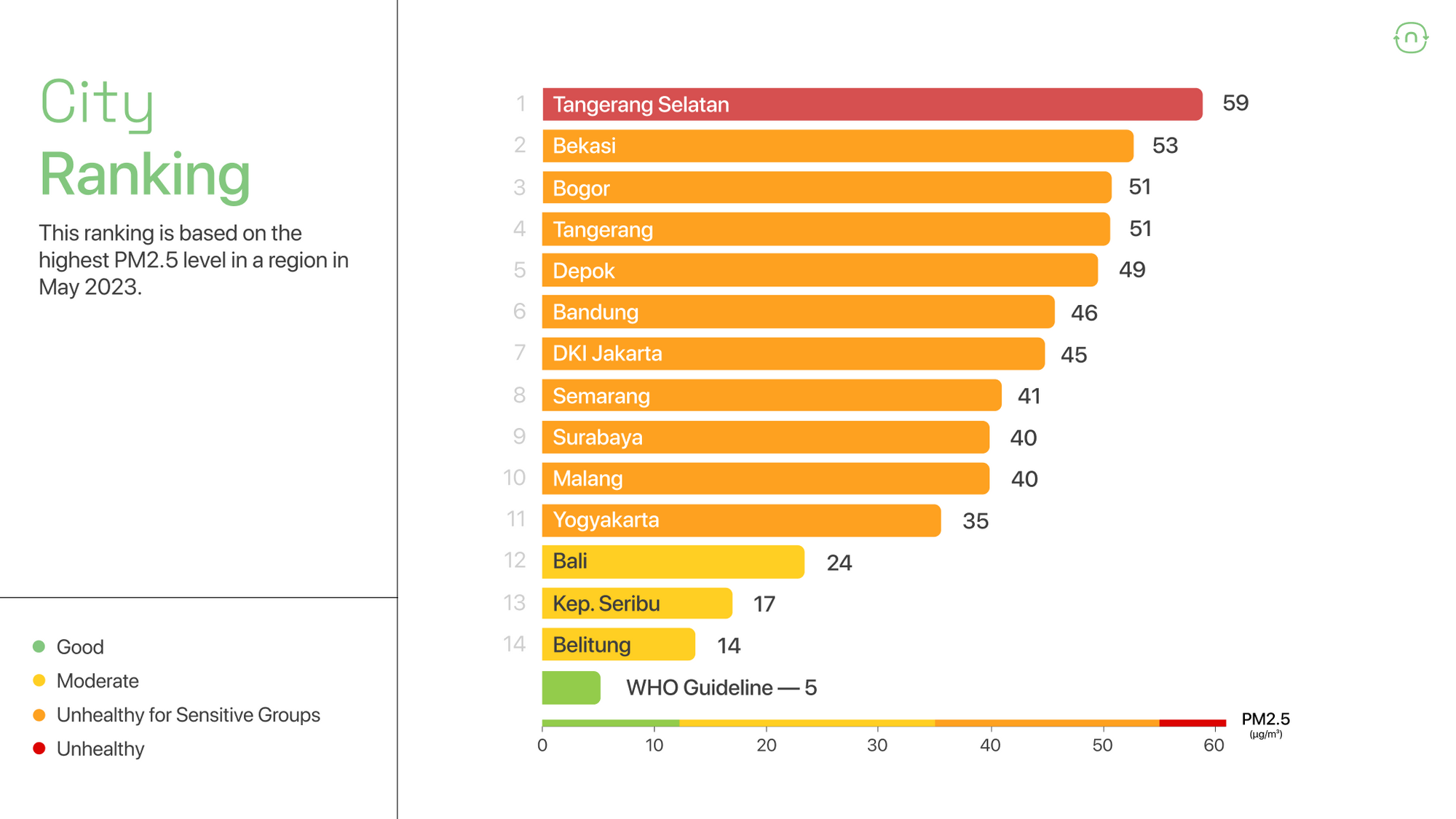Air Pollution Crisis Escalates in May: Citizens Cry for Help
💡 Summary
- In May, Tangerang Selatan, Bekasi, Bogor, Tangerang, and Depok became the five areas with the worst air quality.
- Tarumajaya area in Bekasi has an air quality equivalent to the smoke of 115 cigarettes.
May witnessed a bleak state of air quality, with gray dominating the skies in various regions. It is evident that this phenomenon was not caused by haze. The level of pollution remained alarmingly high in almost all areas, particularly in Jabodetabek.
Social media platforms were inundated with complaints from concerned citizens about the escalating threat of air pollution, particularly its impact on children's health. Mass media extensively covered the deteriorating air quality in Jabodetabek, emphasizing its uncontrollable nature.
While DKI Jakarta often grabs international attention as one of the most polluted cities in the world, how did its air quality fare this month?
According to the Nafas May 2023 Air Quality Report, the pollution levels in surrounding cities surpassed those in DKI Jakarta!
Apart from the presence of local pollution sources, the increase in air pollution can be attributed to the presence of an inversion layer (commonly known as a trapping layer) that contributes to the accumulation of pollutants, making them appear closer to the surface.
This observation aligns with the Nafas sensor data in Jabodetabek from May 1st to May 31st. The air quality outside Bogor, Depok, Tangerang, and Bekasi consistently worsened, surpassing DKI Jakarta throughout the month.
Real Health Impacts of Air Pollution
Residents are urged to exercise caution due to the actual health hazards posed, especially to children and individuals with asthma and allergies. A study published in the British Medical Journal reveals that children exposed to high levels of PM2.5 pollution have an increased risk of developing asthma and experiencing wheezing compared to those unexposed to pollution. This risk is further amplified if the child's parents have a history of asthma.
Collaborative research conducted by Nafas and a telemedicine company revealed that during a significant surge in PM2.5 levels, reaching 65 µg/m3 in June 2022, asthma consultations doubled and influenza cases quadrupled within a 24-hour period in the Jabodetabek area, compared to a baseline of 29 µg/m3.
In the final week of May, an increase in respiratory complaints among children was observed. Pediatric Specialist Dr. Shela Putri Sundawa, explained, "Many children are experiencing coughs, colds, or upper respiratory tract infections. There is also a high prevalence of asthma and allergies.”
These are the tangible consequences of pervasive high pollution levels that affect nearly the entire region. Tarumajaya (Bekasi), Serpong (Tangsel), and Bedahan (Depok) were identified as the three areas with the worst air quality in May.
In fact, if we were to quantify the air quality in Tarumajaya (Bekasi) in terms of cigarettes, it would be equivalent to inhaling 115 cigarettes in just one month!
Air pollution is not confined to Jakarta alone.
Its dangers also threaten the residents of Bandung, Yogyakarta, Semarang, Surabaya, and Malang. Although the pollution levels in these cities may not be as severe as those in the capital and its surroundings, they should not be taken lightly. Notably, Bandung ranks as the most polluted city outside Jabodetabek, with PM2.5 levels peaking at 56 µg/m3 in the third week of May (11 times higher than the WHO guidelines)!
It is high time that we become more concerned and critical in addressing the issue of air quality. Health threats caused by pollution are always present and can become silent killers if comprehensive and large-scale improvements in air quality are not implemented by the government.
While it may be impossible to completely avoid the various sources of air pollution, we can take steps to reduce our exposure. Here are several actions you can take:
- Download the Nafas app and regularly check the air quality before engaging in outdoor activities.
- Wear a respirator mask (N95/KN95) when going outside.
- During periods of high pollution levels, close ventilation. Additionally, consider investing in an air purifier with a HEPA filter and turn it on when the air quality worsens.
- Consult the comprehensive recommendations provided in the Nafas app, which are based on real-time air quality data.
🔗 Download The Nafas May 2023 Air Quality Report 👉 https://bit.ly/NBDMei2023